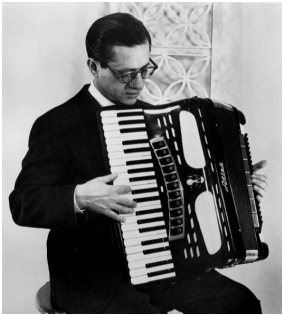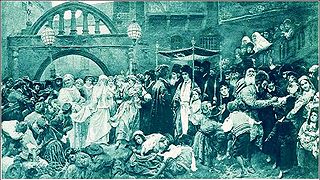
A wedding is a ceremony where two people are united in marriage. Wedding traditions and customs vary greatly between cultures, ethnic groups, races, religions, denominations, countries, social classes, and sexual orientations. Most wedding ceremonies involve an exchange of marriage vows by a couple, presentation of a gift, and a public proclamation of marriage by an authority figure or celebrant. Special wedding garments are often worn, and the ceremony is sometimes followed by a wedding reception. Music, poetry, prayers, or readings from religious texts or literature are also commonly incorporated into the ceremony, as well as superstitious customs.
A white wedding is a traditional formal or semi-formal wedding originating in Great Britain.

A wedding reception is a party usually held after the completion of a marriage ceremony as hospitality for those who have attended the wedding, hence the name reception: the couple receive society, in the form of family and friends, for the first time as a married couple. Hosts provide their choice of food and drink, although a wedding cake is popular.

A wedding dress or bridal gown is the dress worn by the bride during a wedding ceremony. The color, style and ceremonial importance of the gown can depend on the religion and culture of the wedding participants. In Western culture, the wedding dress is most commonly white, a fashion made popular by Queen Victoria when she married in 1840. In Eastern cultures, brides often choose red to symbolize auspiciousness.
The "Bridal Chorus" from the 1850 opera Lohengrin by German composer Richard Wagner, who also wrote the libretto, is a march played for the bride's entrance at many formal weddings throughout the Western world. In English-speaking countries, it is generally known as "Here Comes the Bride" or "Wedding March", but "wedding march" refers to any piece in march tempo accompanying the entrance or exit of the bride, notably Felix Mendelssohn's "Wedding March". Wagner’s piece was made popular when it was used as the processional at the wedding of Victoria the Princess Royal to Prince Frederick William of Prussia in 1858.

Felix Mendelssohn's "Wedding March" in C major, written in 1842, is one of the best known of the pieces from his suite of incidental music to Shakespeare's play A Midsummer Night's Dream. It is one of the most frequently used wedding marches, generally being played on a church pipe organ.

John Serry Sr. was an American concert accordionist, arranger, composer, organist, and educator. He performed on the CBS Radio and Television networks and contributed to Voice of America's cultural diplomacy initiatives during the Golden Age of Radio. He also concertized on the accordion as a member of several orchestras and jazz ensembles for nearly forty years between the 1930s and 1960s.

Squeeze Play is an Ultra High Fidelity monaural phonographic album which was released on the Dot Records label in 1956 (DLP-3024) featuring John Serry Sr. It includes an original composition by Serry, classical works, and popular music of the era. Ben Selvin serves as the musical director/producer for the album. The works were arranged by Serry and performed with his ensemble featuring two accordions, piano, guitar, bass, drum, vibes, and marimba.

RCA Thesaurus, a brand owned by RCA Victor, was a supplier of electrical transcriptions. It enjoyed a long history of producing electrical transcriptions of music for radio broadcasting which dated back to NBC's Radio Recording Division.

A Jewish wedding is a wedding ceremony that follows Jewish laws and traditions. While wedding ceremonies vary, common features of a Jewish wedding include a ketubah which is signed by two witnesses, a chuppah or huppah, a ring owned by the groom that is given to the bride under the canopy, and the breaking of a glass.

The traditional Vietnamese wedding is one of the most important ceremonies in Vietnamese culture, which is influenced by Confucian and Buddhist ideologies.
A wedding song is a song sung as wedding music

American Rhapsody was written for the accordion by John Serry Sr. in 1955 and subsequently transcribed for the free-bass accordion in 1963 and for the piano in 2002. The composer was inspired by the classical orchestral works of George Gershwin along with various Latin jazz percussive rhythms utilized throughout South America while composing this opus.
Iranian wedding, also known as Persian wedding, consists of traditions rooted in Zoroastrianism, the primary religion of pre-Islamic Iran. Though the concepts and theories of marriage have been changed by Islamic traditions, the ceremonies have remained more or less the same as they were originally in pre-Islamic Iran. Although modern-day Iran is a multi-ethnic country, Iranian wedding traditions are embraced by the majority of ethnic groups in Iran.

Punjabi wedding traditions are a strong reflection of Punjabi culture with ritual, song, dance, food, and dress that have evolved over centuries.
In the United States and Canada, weddings follow traditions often based on religion, culture, and social norms. Most wedding traditions in the United States and Canada were assimilated from other, generally European, countries. Marriages in the U.S. and Canada are typically arranged by the participants and ceremonies may either be religious or civil. There is a tradition that the prospective bridegroom ask his future father-in-law for his blessing.

Traditional marriage customs in the Philippines and Filipino wedding practices pertain to the characteristics of marriage and wedding traditions established and adhered by them Filipino men and women in the Philippines after a period of adoption courtship and engagement. These traditions extend to other countries around the world where Filipino communities exist. Kasalan is the Filipino word for "wedding", while its root word – kasal – means "marriage". The present-day character of marriages and weddings in the Philippines were primarily influenced by the permutation of Christian, both Catholic and Protestant, Hindu, Islam, Chinese, Spanish, and American models.
Weddings in Myanmar, considered auspicious occasions in Burmese culture, reflect various ethnic, religious, and regional traditions. Depending on an individual's family social economic status, personal preferences and titles held, Burmese weddings can be religious or secular, and extravagant or simple. Wedding expenses are covered by the groom's family. Myanmar is a predominantly Buddhist country, and many wedding customs and traditions are influenced by Buddhism.
Mahāgīta, also rendered into Burmese as Thachingyi, is the complete body or corpus of Burmese classical songs. The songs descend from the musical traditions of the Burmese royal court, and form the basis of Burmese classical music today. Mahāgīta songs continue to be played during Buddhist rituals, weddings, and public festivals, and performers frequently appear on state-run television shows.













